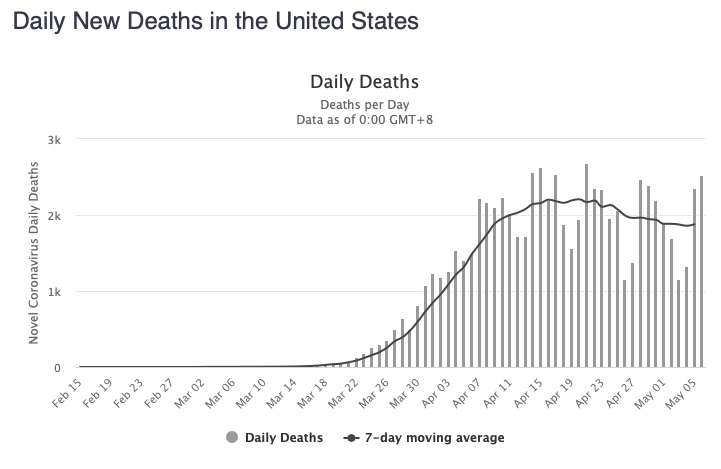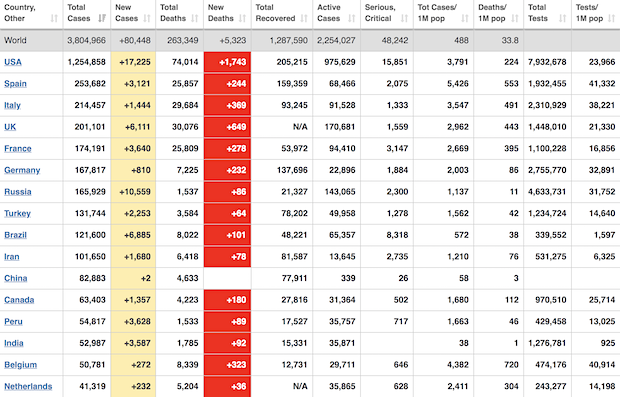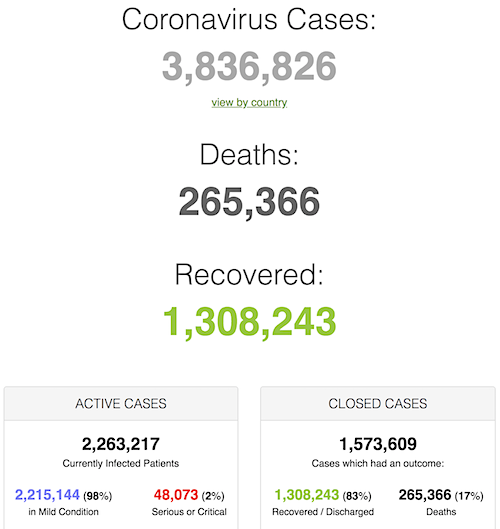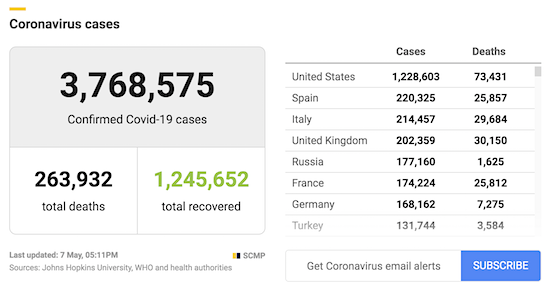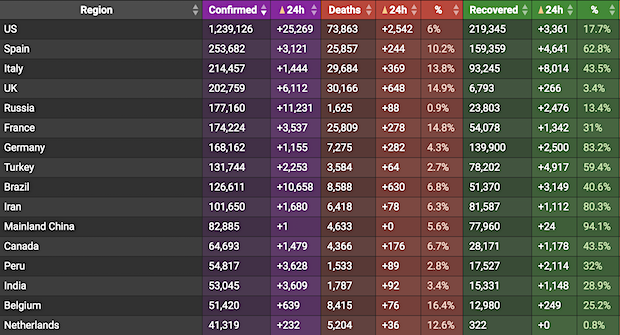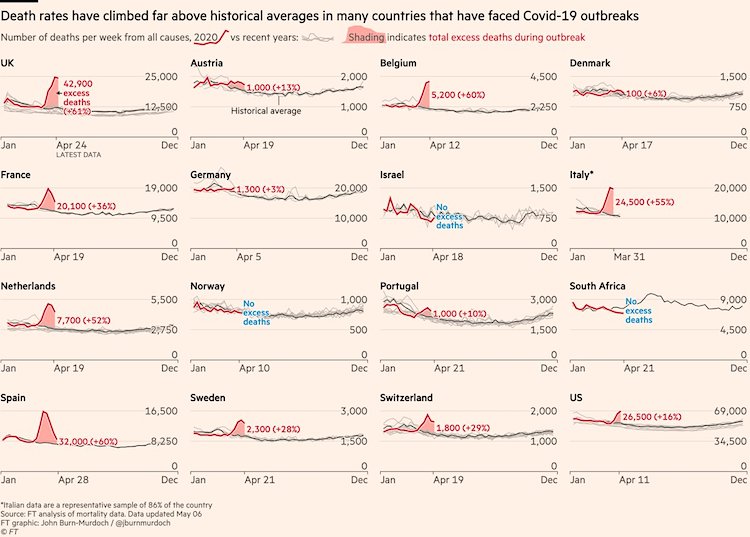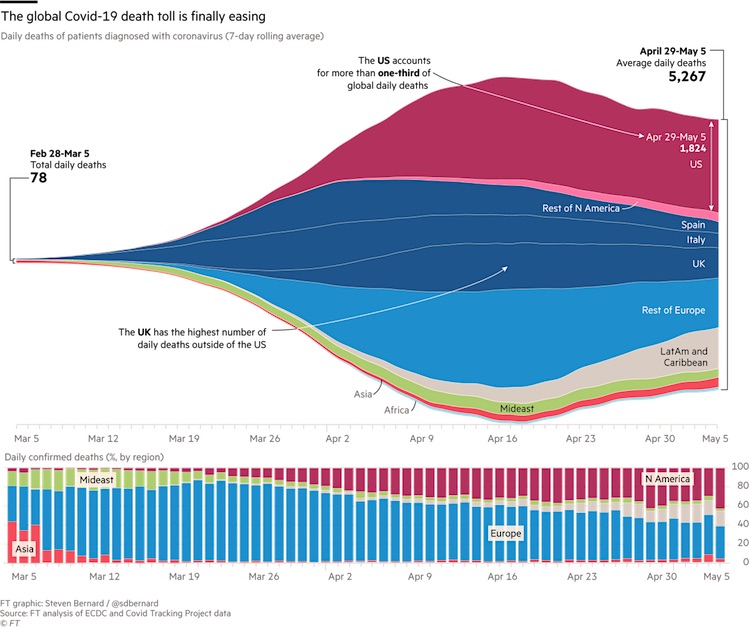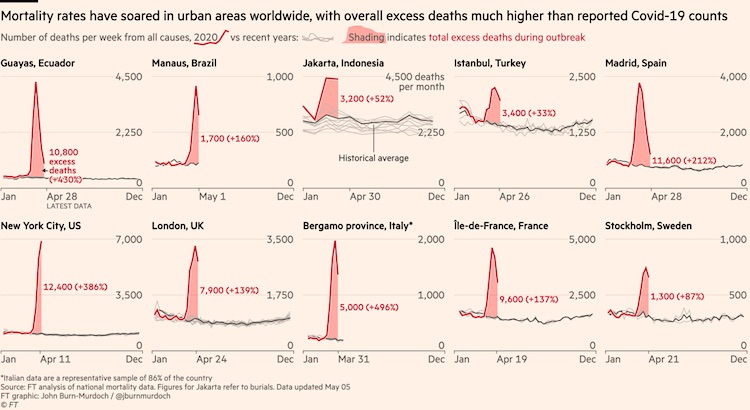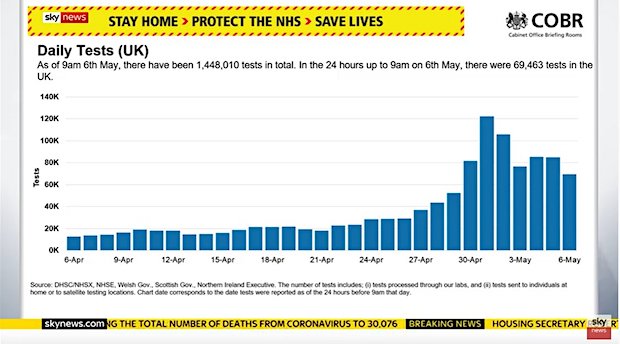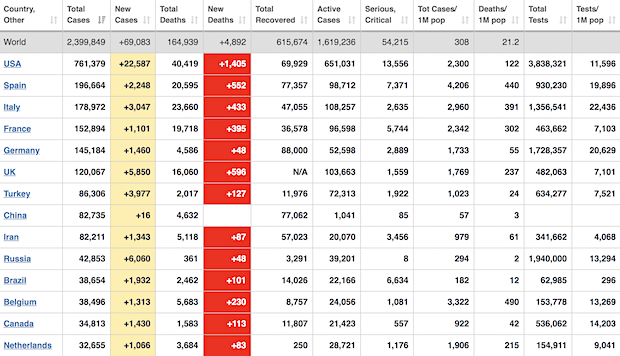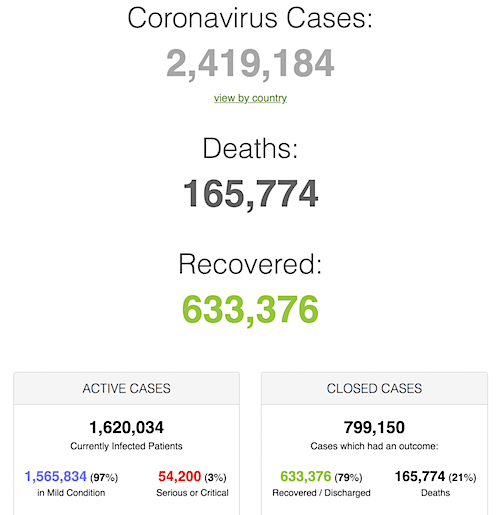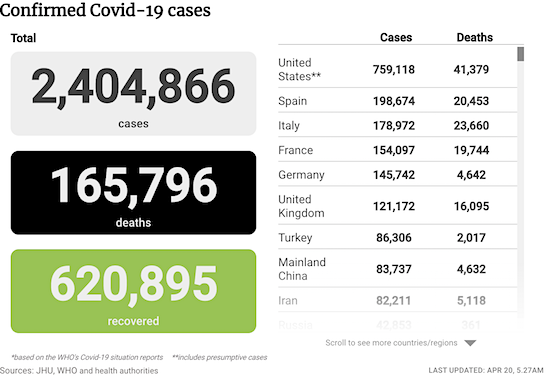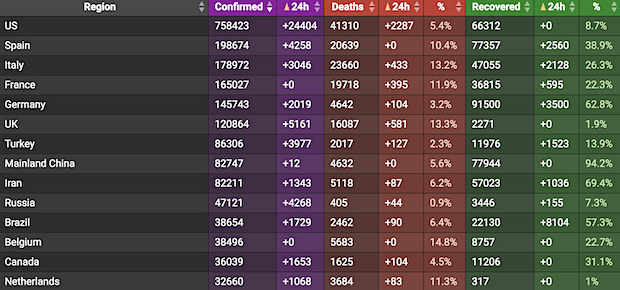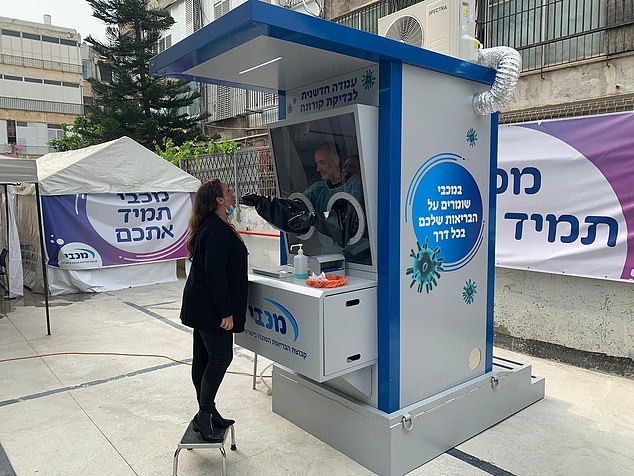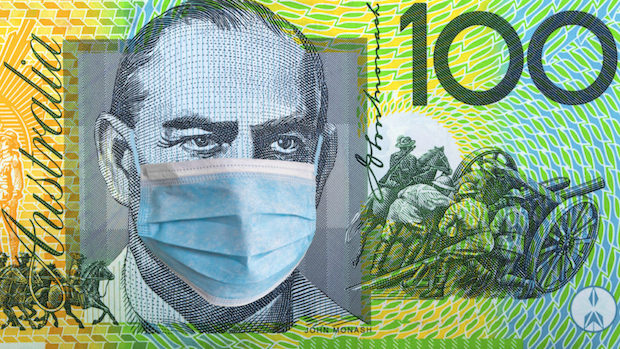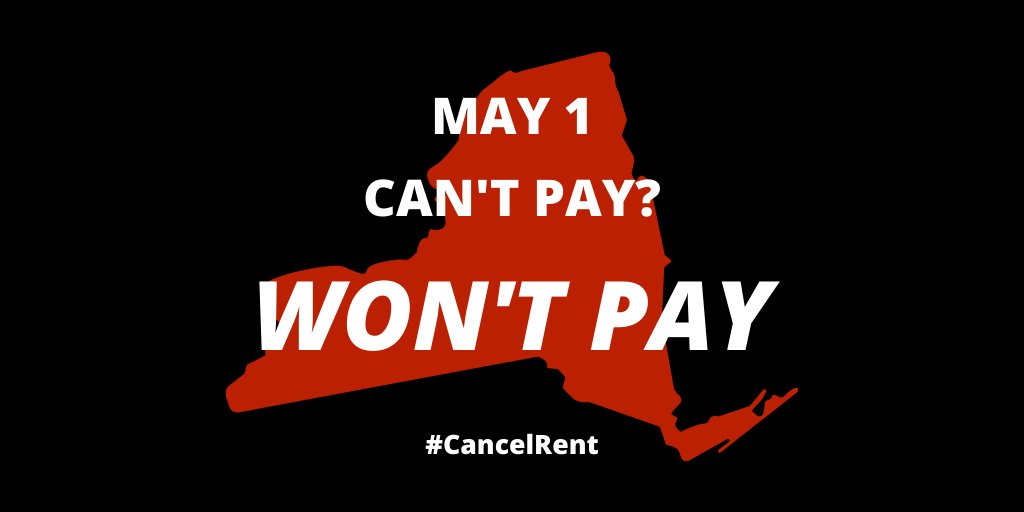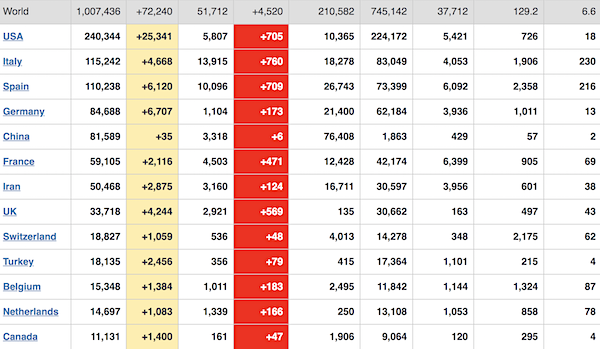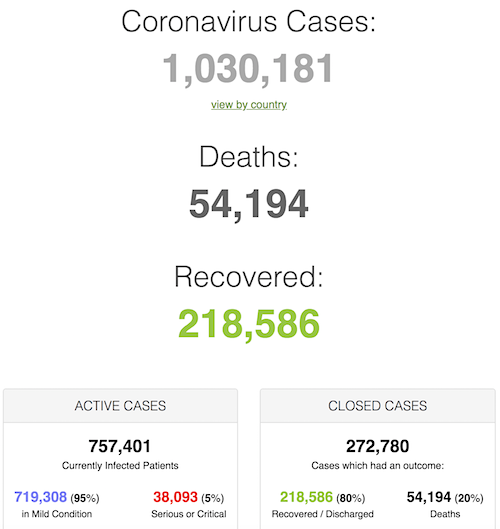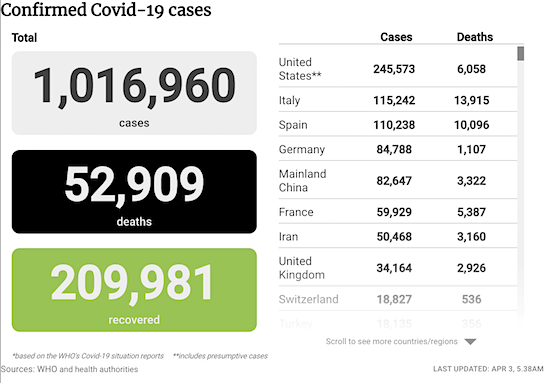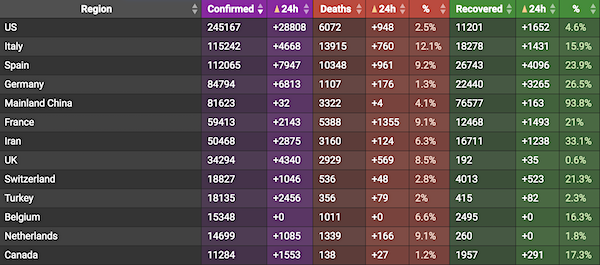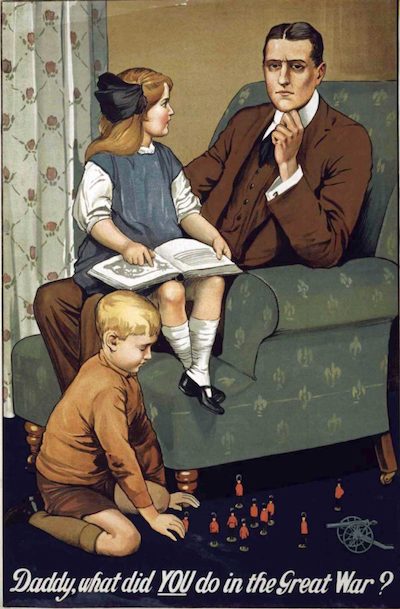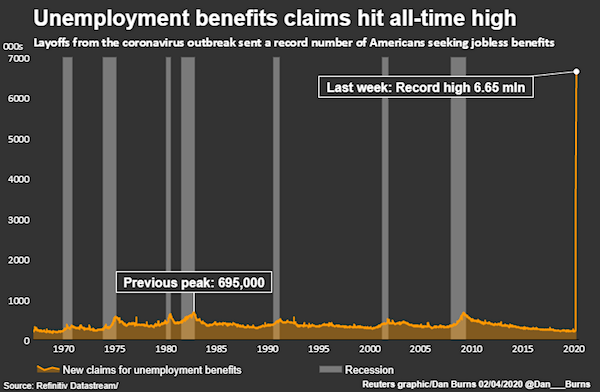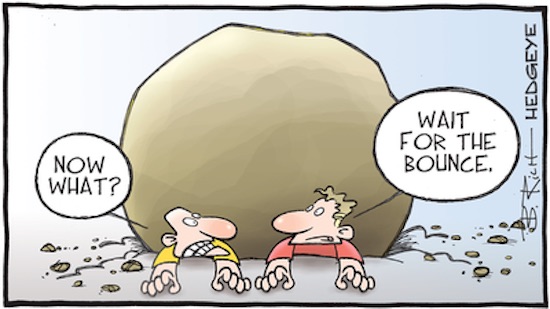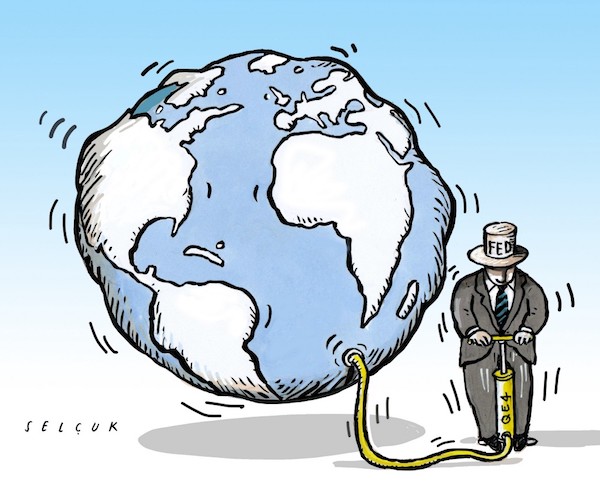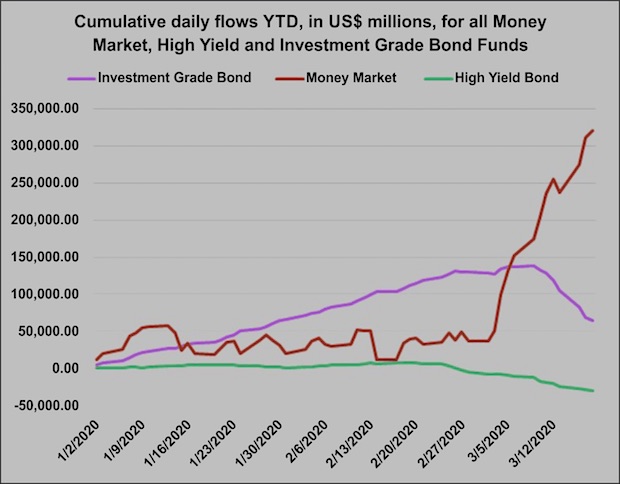
Jack Delano Myrtle Beach, S.C. Air Service Command Technical Sergeant Choken 1943

• US records 857 new #coronavirus deaths in 24 hours. Yesterday: 1,277
• The latest toll, marked at 8:30 pm (0030 GMT Monday), is the lowest since 776 daily deaths were recorded May 10, but the count ranged as high as 1,894 in subsequent days

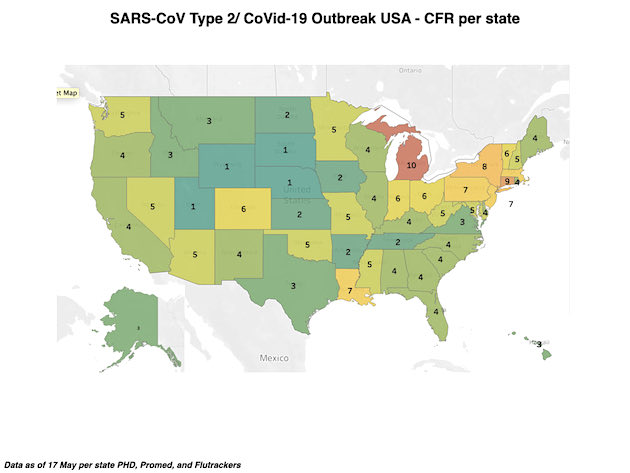
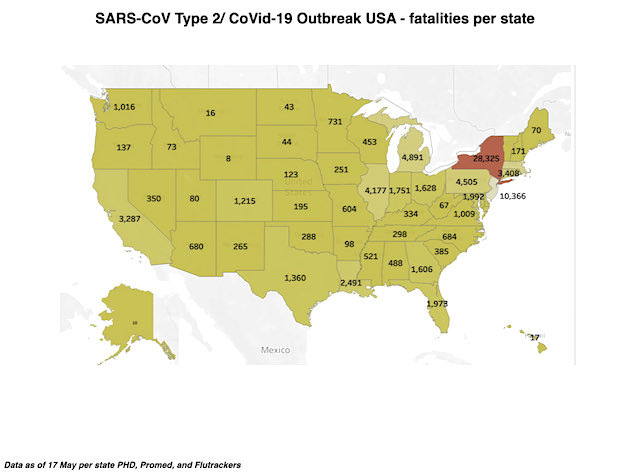
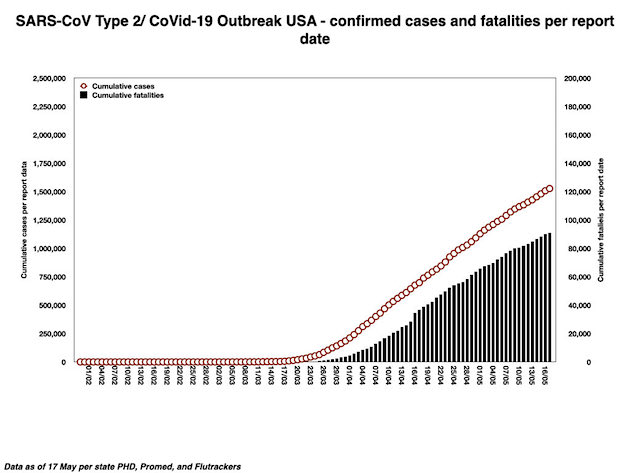

Europe is improving:
20 countries Winning,
21 countries Nearly There, and
10 countries Needing to ActCan you guess which are which? Answers in the attached pic.twitter.com/QTyJtntgLg
— Yaneer Bar-Yam (@yaneerbaryam) May 18, 2020

• Cases 4,820,347 (+ 77,166 from yesterday’s 4,743,181)
• Deaths 316,967 (+ 3,264 from yesterday’s 313,703)

From Worldometer yesterday evening -before their day’s close-
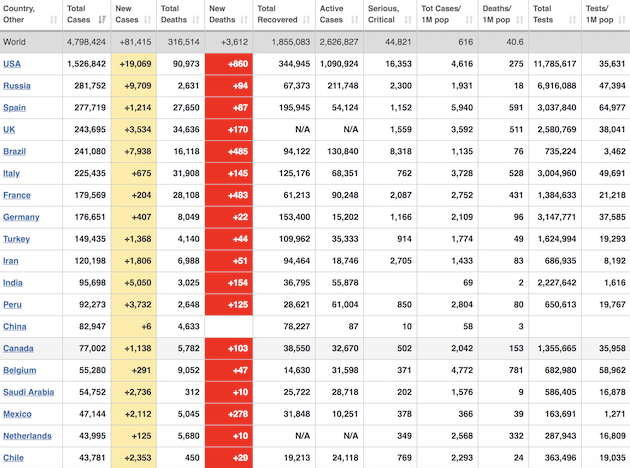
From Worldometer
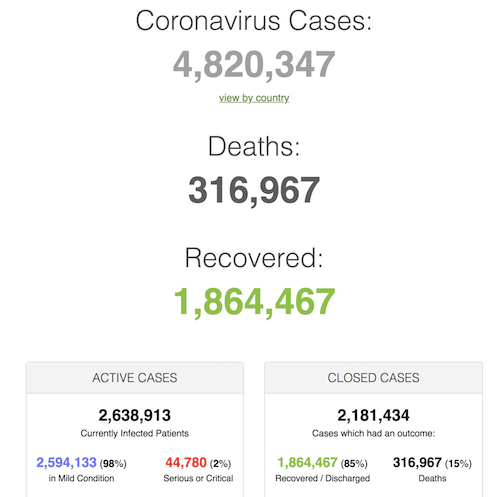
From SCMP:
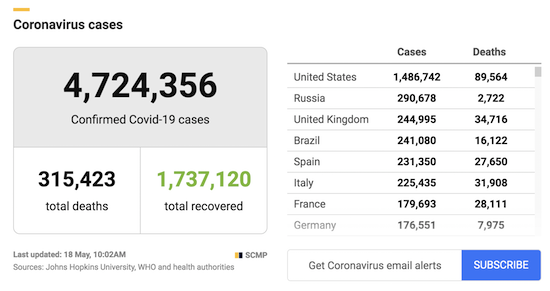
From COVID19Info.live:
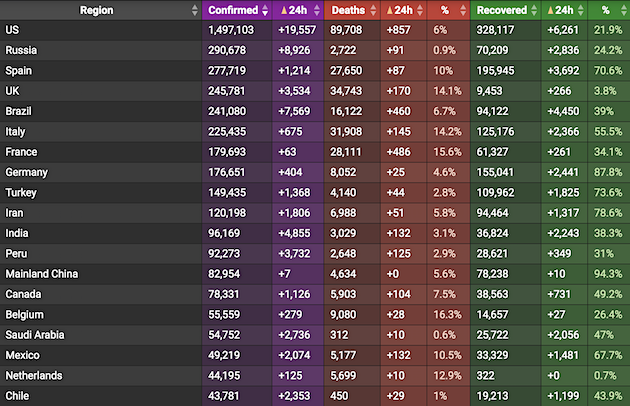

Say your child sees the Lord of the Rings films and wants to visit New Zealand. What do you think are the odds they’ll be allowed entry any time soon?
• Ardern Becomes New Zealand’s Most Popular PM In A Century (R.)
Jacinda Ardern became New Zealand’s most popular prime minister in a century, a Newshub-Reid Research poll showed on Monday, thanks to her COVID-19 response that made the country among the most successful in curbing the spread of the disease. The first public poll since the coronavirus crisis took hold showed popularity for Ardern’s Labour jumped 14 points to 56.5% – the highest for any party ever. Conversely, the biggest party in parliament – the Nationals, slumped to 30.6%, after sliding by 12.7 points. The poll was conducted between May 8 and May 16, with half of the responses taken after the federal budget on Thursday. As preferred PM, Ardern was at 59.5%, up 20.8 points on the last poll and the highest score for any leader in the Reid Research poll’s history.
The poll took into account public sentiment in the final days of the country’s strict level three lockdown, which also got massive support with almost 92% respondents saying it was the right call. The Pacific nation was locked down for more than a month under “level 4” restrictions that were eased by a notch in late April. It has continued to enforce strict social measures on many of its citizens and businesses, helping prevent widespread community spread of the virus. Businesses in the country including malls, cinemas, cafes and gyms reopened last Thursday. (May 14) Ardern’s stratospheric rise to become the country’s youngest prime minister and third woman to hold the office resulted in New Zealanders coining the phrase “Jacinda-mania.” The rate of new cases have slowed dramatically in New Zealand in recent weeks. The virus has so far infected 1,499 people in New Zealand and killed 21.

China says it’s premature to start now because the pandemic is not over. What?
• 116 Countries Back Australia’s Push For Independent Corona Inquiry (SBS.au)
110 countries have backed Australia’s push for an independent coronavirus inquiry which has caused a damaging rift with China. The African Group’s 54 member states will co-sponsor the motion, joining 62 other countries including Russia, Indonesia, India, Japan, Britain and Canada. The European Union’s 27 members are all on board, along with Brazil, South Korea, Mexico, Turkey and New Zealand. Foreign Minister Marise Payne on Monday said it was encouraging to see so many countries backing the inquiry. “I think what it illustrates is a broad view that given the experience of COVID-19 – over 300,000 deaths, millions of people around the world losing their jobs, the impact on economies from one corner of the globe to the other – that there is a strong view that it is appropriate to engage in a review of what has happened.
“I don’t want to preempt speculate about the outcome, those discussions will be under way later this evening. I think it’s a win for the international community.” The draft resolution calls for impartial, independent and comprehensive evaluation of the international response to the pandemic. It doesn’t mention China, but Australia’s push for the inquiry has angered Beijing, which has threatened a huge tariff on barley and blocked some beef imports. Health Minister Greg Hunt will represent Australia at the virtual World Health Assembly meeting on Monday night. A vote is expected in the early hours of Tuesday.

One little problem: the UK itself is not a low risk country.
• Start ‘Travel Bubbles’ For Low-Risk Countries, Heathrow Urges UK Govt (R.)
Britain should set up “travel bubbles” with low-risk countries to allow the movement of people, instead of bringing in new coronavirus quarantine rules when flights restart, according to Heathrow Airport. British government ministers have said they plan a 14-day quarantine for most people arriving in the country in the coming weeks to try to prevent a second peak of the pandemic. Airlines have warned the policy will throttle hopes for a travel recovery. Heathrow Airport, which before the novel coronavirus grounded planes was the busiest in Europe, said that it had been working with the UK government’s Department for Transport on proposals to allow some unrestricted travel.
“The proposal would create ‘travel corridors’ or ‘travel bubbles’ allowing free movement between countries or cities that are very low-risk, but potentially blocking flights from high-risk markets to safeguard public health,” the airport said in a statement. Such a set-up would be much less damaging to the economy than the quarantine policy, said Heathrow. The boss of Ryanair, Europe’s biggest airline by passenger numbers, said on Monday that the 14-day policy was unimplementable and unpoliceable and would be ignored by people wanting to travel. The government is yet to provide further details of the quarantine policy. Culture minister Oliver Dowden said earlier on Monday that Britain was still in talks with France over whether to exempt travellers from across the Channel.

You can’t go through years of Russiagate and Syria bombings and expect countries to work together. And western Pharma sees huge profits anyway; that’s society’s model after all.
• Profiting from Coronavirus (Craig Murray)
On 5 May, the British security services released to their pet media the claim that Russia, China and Iran were attempting to hack into British research institutes conducting coronavirus research. The BBC reported it. Britain’s shameful copy and paste media all, without exception, just copy and pasted the government press release. The Guardian gave the quote: “Any attack against efforts to combat the coronavirus crisis is utterly reprehensible. We have seen an increased proportion of cyber-attacks related to coronavirus and our experts work around the clock to help organisations targeted”.
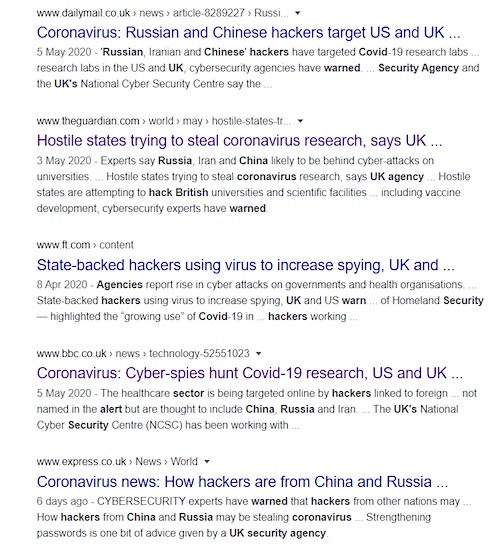
If Britain had one single mainstream media journalist willing to think, rather than just regurgitate government propaganda, they might have realised that there is a massive story here if you look at it the other way round. The quote from the Guardian deliberately attempted to give the impression that Russia, China and Iran were trying to disable, destroy or hamper coronavirus research: “Any attack against efforts to combat the coronavirus”. But if you read carefully through those articles, you find that the allegation is merely that they are attempting hack in to gain access to the research. Because the UK and the US are attempting to hide their vaccine and treatment research results from the rest of the world to make money out of them.
Much has been written about the possibility for a new and better kind of world to emerge after coronavirus. Yet our governments cannot conceive of any model for fighting this threat to the whole world, other than the capitalist, money-making model. The much-touted “race to develop a vaccine” is not a race to save lives. It is a race to make billions. The United States and the United Kingdom are working in all international fora to head off efforts to pool global research and to make any vaccine or medicine a good for the world. Governments can reward those working on the vaccine, and the companies for providing the facilities, using economic models other than the patent and the potential for massive profit.
It may come as a shock to you to realise that at the moment all those lovely vaccine and medicine researchers you see being interviewed on TV about their efforts to compress trials and approvals and get the product to the marketplace, are not sharing their results with fellow researchers around the world. They are rather jealously guarding them and each working in a bubble hoping to be the first in order to cash in. It is certainly true that many of the researchers themselves do not like this, but are controlled by their bosses.
For me, the failure to set up a worldwide shared scientific database on all coronavirus vaccine and medicine research, and the failure to set up a prior agreement on free manufacture worldwide of effective resulting vaccines and treatments, is the most revealing fact about the entire coronavirus episode. The fact that the British government is putting massive resources into ensuring the Chinese or Russians cannot “steal” our research – and doubtless the Chinese and Russians are doing the same, all states are hypocrites in these matters – should sicken everybody.

More incentive for collective action on vaccines.
• US Mulls Paying Companies, Tax Breaks To Pull Supply Chains From China (R.)
U.S. lawmakers and officials are crafting proposals to push American companies to move operations or key suppliers out of China that include tax breaks, new rules, and carefully structured subsidies. Interviews with a dozen current and former government officials, industry executives and members of Congress show widespread discussions underway – including the idea of a “reshoring fund” originally stocked with $25 billion – to encourage U.S. companies to drastically revamp their relationship with China. President Donald Trump has long pledged to bring manufacturing back from overseas, but the recent spread of the coronavirus and related concerns about U.S. medical and food supply chains dependency on China are “turbocharging” new enthusiasm for the idea in the White House.
On Thursday, Trump signed an executive order (here) that gave a U.S. overseas investment agency new powers to help manufacturers in the United States. The goal, Trump said, is to “produce everything America needs for ourselves and then export to the world, and that includes medicines.” But the Trump administration itself remains divided over how best to proceed, and the issue is unlikely to be addressed in the next fiscal stimulus to offset the coronavirus downturn. Congress has begun work on another fiscal stimulus package but it remains unclear when it might pass. The push takes on special resonance in an election year. While anti-China, pro-American job proposals could play well with voters, giving taxpayer money or tax breaks to companies that moved supply chains to China at a time when small business is flailing may not.

Now Cuomo starts arguing that “all those old people would have died anyway”. Afraid he’ll be blamed?
• Cuomo Says No One Should Be Prosecuted For Coronavirus Deaths In New York (CBS)
New York Governor Andrew Cuomo on Sunday addressed the state’s early response to the coronavirus outbreak and said “nobody” should be prosecuted for the those who died, noting that “older people” were most vulnerable. The governor has been criticized for a decision in March, which has since been reversed, to send patients back to nursing homes after they tested positive for COVID-19. More than 4,800 people died from COVID-19 in nursing homes in the state between March 1 and May 1, according to a tally released by the Cuomo administration on May 1. Cuomo has called nursing homes a “feeding frenzy” for the coronavirus. “Despite whatever you do, because with all our progress as a society, we can’t keep everyone alive,” Cuomo said.
The number of deaths in New York state dropped again Saturday to 139 people. When asked about the nursing home deaths, Cuomo noted the 139 people who died on Saturday and asked who is accountable for everyone who died. “How do we get justice for those families of those 139 deaths?” Cuomo said. “Who can we prosecute for those 139 deaths? Nobody. Mother Nature, God, where did this virus come from? People are going to die by this virus, that is the truth.” When pressed further about how some people thought their loved ones would be safe because of Matilda’s Law, Cuomo continued to stress the point that older and more vulnerable people were “always going to die from this virus.”
He said when talking who is accountable for deaths, the most important thing was to make sure “you can have a situation where everyone did the right thing and everyone tried their best.” Cuomo said his top priority was making sure the medical system did not get overwhelmed, calling that a “accountable, avoidable situation.” “That’s what we protected against and we did it successfully,” Cuomo said. Cuomo pushed for all New Yorkers who have symptoms of COVID-19 to get tested. He said New York is now conducting 40,000 tests per day at 700 testing sites. “If you think you have symptoms, get a test. It’s up to you,” he said. “We just don’t have enough New Yorkers coming to be tested.”

The GOP will negotiate to make sure its sponsors get a “fair” chunk of the loot. And that’ll be all she wrote.
• Pelosi Sees Negotiations On New $3 Trillion Coronavirus Legislation (R.)
U.S. House Speaker Nancy Pelosi said on Sunday there will be negotiations on the new $3 trillion coronavirus relief legislation passed by the Democratic-controlled House of Representatives and that Democrats have “no red lines.” Asked if there has been a Republican response or counteroffer to begin negotiations on the bill passed late on Friday, Pelosi said, “No bill that is proffered will become law without negotiations, so, yeah.” The Democrats’ measure, passed late on Friday, was likely to trigger new talks with congressional Republicans and President Donald Trump’s administration, who have been talking about the need for new business liability protections in the age of coronavirus, or additional tax cuts.
Democrats oppose both of those ideas. Pelosi, however, told CBS’ “Face the Nation” on Sunday that Democrats had “no red lines.” Republican leaders have dismissed the bill, which Trump said he would veto, with Senate Majority Leader Mitch McConnell calling it “dead on arrival.” Some Republicans have said a new relief package could wait until the effects of funding in previous bills are felt, but Pelosi urged a quick resolution to help jobless Americans. More than 36 million people – or more than one in five workers – in the United States have filed for unemployment since the crisis began. “Time is of the essence,” Pelosi said. “In the past bills, they’ve put forth their proposal and then we worked in a bipartisan way. That’s what we all anticipate.”

Just as misguided as Pelosi.
• Senator Rubio Calls For Fast Action To Extend US Payroll Protection Program (R.)
The United States needs to quickly revise its coronavirus aid program for small businesses to extend the eight-week period in which the law currently requires companies to spend the money, a key U.S. senator said on Sunday. The Paycheck Protection Program established by Congress in late March was aimed at helping businesses keep making payroll for eight weeks, despite orders to shutdown because of the coronavirus pandemic. The eight-week period may be applied to any time frame from mid-February up to June 30. But with many businesses that received loans under the $660 billion PPP program moving toward the end of their eight-week period, Senator Marco Rubio, the Republican chairman of the Senate’s small business committee, said lawmakers need to move fast to extend it.
“The legislative fix needed to #PPP is extending beyond 8 weeks the time period a #SmallBusiness has to spend the funds on payroll. We are hoping to move quickly on this before the first wave of #PPP loan recipients reach the 8 week point,” Rubio wrote on Twitter. While most states have begun to reopen their economies at least in part, some 36 million Americans — one in five in the workforce — have lost their jobs since the pandemic began. Rubio’s Republican party has the majority in the Senate. But the top Democrat on the small business committee, Senator Ben Cardin, has also expressed support for re-examining the eight-week period in the small business program. “I strongly support extending it,” another Senate Democrat, Chris Van Hollen of Maryland, a member of the banking committee, said in a phone interview Sunday. “There’s a real mismatch between that date and the real world situation that many small businesses are facing.

How about only when around people?
• Los Angeles Tells Everyone To Wear Face Masks At All Times While Outdoors (JTN)
Los Angeles is requiring essentially everybody in the city wear a face covering at all times whenever outdoors, a policy Mayor Eric Garcetti says will help the local economy reopen faster. Garcetti announced the order on Wednesday evening, telling city residents: “Bring your mask with you whenever you leave your home.” Children under 2, as well as a limited number of individuals with disabilities, are exempt from the order, the mayor’s office said in a press release. “Face coverings help stop the spread of the virus,” Garcetti, a Democrat, said in the release. “Wearing them whenever we’re away from home will create a meaningful layer of protection for people we might come into contact with, and that makes sense at this stage of our response to the crisis.”
The order came shortly after Garcetti said that the city will “never be completely open” until scientists discover a cure for coronavirus. The mayor at the time was partially walking back comments made earlier in the day by Los Angeles County Public Health Director Barbara Ferrer, who said Tuesday that the city’s stay-at-home order would be extended “with all certainty” for the next three months.

Complete nonsense: “Ensuring a competitive level playing field within its cherished single market of some 450 million people is a central EU tenet”..
Self-contradicting: “..concern about the “huge differences” in coronavirus state aid among member states, saying they were starting to distort the bloc’s single market.”
vs
“..Germany’s extensive bailouts of coronavirus-hit companies could have a ripple effect across the bloc and work as a locomotive for Europe..”
• EU’s Vestager: Discrepancy In Coronavirus State Aid Distorts Single Market (R.)
The European Union’s competition chief Margrethe Vestager has expressed concern about the “huge differences” in coronavirus state aid among member states, saying they were starting to distort the bloc’s single market. Germany accounts for more than half of the emergency coronavirus state aid approved by the EU executive, prompting concerns that countries with the deepest pockets might be getting an unfair advantage in the bloc’s single market. In an interview with German newspaper Sueddeutsche Zeitung, Vestager said there was a risk that the different levels of state aid among member states would distort competition and slow the economic recovery from the coronavirus pandemic.
“And this has already happened to a certain extent”, Vestager said, according to a pre-released extract of the interview that the newspaper will publish in its Monday edition. Ensuring a competitive level playing field within its cherished single market of some 450 million people is a central EU tenet and has long been a key condition for opening up to foreign players from China to, more recently, Brexit Britain. But the executive European Commission suspended the normally-strict state aid restrictions in mid-March, allowing the 27 EU states to pump cash into their economies and companies battered by coronavirus, with more than 1.9 trillion euros worth of national schemes approved so far.
Earlier this month, Vestager said that Germany’s extensive bailouts of coronavirus-hit companies could have a ripple effect across the bloc and work as a locomotive for Europe. Asked about an EU recovery plan expected to be announced on May 27, Vestager said there were no guarantees that it would be sufficient but said officials were trying to do their best.

It’s not the virus, it’s the housing bubble that’ll decide this.
• Australia Bankers Hope They’ll Avoid A Bad Debt Tsunami (AFR)
On the face of it, the stats look abysmal. There are 7.7 million Australian workers on some form of government welfare. Repayments have been frozen on 10 per cent of mortgages and 15 per cent of SME loans. Bankers have been left with about $220 billion in loans that aren’t being serviced. Little wonder then that some analysts are querying whether the $5 billion that the big four banks have set aside to cover the losses they’ll sustain from the economic collapse triggered by the pandemic will be sufficient. Now, bankers continue to emphasise that they won’t know the extent of their problem loans for another month, when they start contacting the home owners and small business owners who opted to defer their loan repayments.
But at this stage, bankers appear quietly optimistic that the rise in their soured loans this time around are unlikely to be anywhere near as serious as the hit they took from the 1990s recession, or even the losses they sustained during the global financial crisis. There are two reasons for this confidence. In the first place, the latest downturn has been very uneven across the economy. Workers in the services sector – particularly hospitality, accommodation, food services and retail trade – have suffered far more than, say, those employed in the finance or government sectors. But because the jobs in these sectors tend to be lower paid, with a higher proportion of younger employees working casual hours, those working in these sectors tend not to meet the income requirements for a home loan borrower.

We try to run the Automatic Earth on people’s kind donations. Since their revenue has collapsed, ads no longer pay for all you read, and your support is now an integral part of the process.
Thank you.

Note: Navarro says in this clip that remdesivir has been saving many lives. But we know it has no such effect. It shortens hospital stays at best.
On @ABC's #ThisWeek, @GStephanopoulos gets SCHOOLED by White House trade adviser Peter Navarro on the administration’s early #COVID responsehttps://t.co/R7TI4VRF4w pic.twitter.com/eKCYQe3t8r
— Nicholas Fondacaro (@NickFondacaro) May 17, 2020

Tang Jie, one of the very smart students in my Sunday seminar, presented the following graph in today’s meeting. It shows subway ridership this year in 30 major Chinese cities compared to the same period last year. Jie pointed out at least three interesting things about this… pic.twitter.com/nqvOnNBq1O
— Michael Pettis (@michaelxpettis) May 17, 2020

I saw @jaketapper had some strong words today about "unprecedented smear campaigns" that include "wild and false allegations."
So I made a Supercut. pic.twitter.com/E3An6PiQi6
— Greg Price (@greg_price11) May 17, 2020

In remote mountains of SW China, this grandma carries concrete mixer back to her village because there are no roads. pic.twitter.com/JWZHlfR40B
— Carl Zha (@CarlZha) May 18, 2020



Support the Automatic Earth in virustime.



